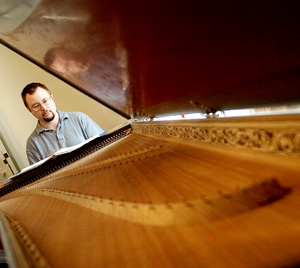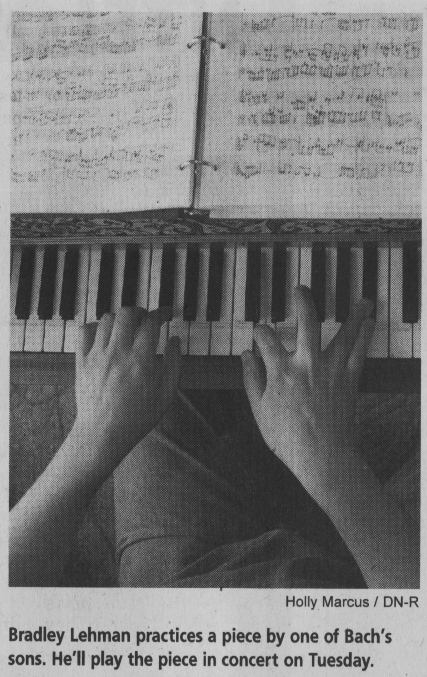|
By MARTIN CIZMAR In Johann Sebastian Bachís obituary, his son Carl Philipp Emmanuel Bach wrote about his feted fatherís most important accomplishments. "In the tuning of harpsichords, he achieved so correct and pure a temperament that all the tonalities sounded pure and agreeable," he wrote. Bach and his sons were the only people who knew how to tune a harpsichord using the familyís special method. That is until almost 255 years later when Bradley Lehman came along. Last year, the Dayton man deciphered a code of spirals drawn on the first page of Bachís manuscript about tuning. It was the only clue left by Bach or his sons pertaining to the closely guarded the secret of how they tuned harpsichords for performances they conducted, Lehman said. "It was somewhat of a family secret," he said. "It gave a little magic to a piece when a Bach played it." Lehmanís discovery was the subject of a two-part article published in a prestigious academic journal. This week, heíll be using it during the Shenandoah Valley Bach Festival at Eastern Mennonite University. Heíll be playing at the opening concert at 3 p.m. on Sunday at Eastern Mennonite Universityís Lehman Auditorium and at noon on Tuesday at Asbury United Methodist Church. A Lifetime Of Preparation Lehman started playing piano at age 6. He started playing the harpsichord, in high school. He became a serious student of both Bach and the harpsichord in college and earned a doctorate in harpsichord from the University of Michigan. Lehman said he knew the spirals meant something when they were first pointed out to him even though the top Bach scholars had written them off as meaningless. "I knew the asymmetry meant something," he said. After he deciphered the code using his knowledge of German, undergraduate degree in mathematics and doctorate in harpsichord from the University of Michigan, Lehman started pouring through his collection of Bachís work. "I played everything I could get my hands on," he said. "It sounded wonderful." Lehman then started working on the article explaining the discovery, which is more than 100 pages long. He made the discovery around Easter of last year and had the first part of the article finished in June. "It was a lot of work, but Iíve been preparing my whole life for this," he says.  Bradley Lehman deciphered Bach's method of tuning
a harpischord, clavichord and piano. This style of
tuning will be showcased during the
opening concert
of the Bach Festival Sunday at Lehman Auditorium,
Eastern Mennonite University.
Bradley Lehman deciphered Bach's method of tuning
a harpischord, clavichord and piano. This style of
tuning will be showcased during the
opening concert
of the Bach Festival Sunday at Lehman Auditorium,
Eastern Mennonite University.
Photo by Holly Marcus Versatile Tuning Method There are at least dozens of different methods of harpsichord tuning used today, Lehman said. Most techniques are designed to have some ranges sound good, but do so at the expense of other ranges. "If you stay in the right keys it sounds right but if you go to the wrong keys youíre dead," he says. Lehman said the most common system, equal temperament, makes every range sound decent, but lets nothing shine. "Nothing sounds terrible but itís just boring," he said. Kenneth Nafziger, director of the Bach festival, hears it too. "When I went to hear him demonstrate it for the first time I was a little worried Iíd have to say I couldnít hear a difference," he says. "But that wasnít the case. The keys have a great deal more personality and individuality." Nafziger said the tuning is "a musician thing" and that some people wonít hear the difference, but that Lehmanís discovery is still exciting. "This will be discussed and debated, by some people it will be trashed and other people will say itís the solution to everything," he says. Not Just For Harpsichords The harpsichord tuning Lehman found can also be used in other key instruments, he says. The method was used in the new organ at Goshen College in Indiana, Lehmanís alma mater. "It seems to work for just about everything," he says. "If you really wanted to you could tune a piano using it." The 25-foot, 1,604-pipe organ was built by Staunton-based Taylor & Boody and featured on the cover of Diapason, the premiere organ industry magazine. George Taylor, co-owner of Taylor & Boody, said heís impressed with Lehmanís discovery. "It was an interesting solution to an ancient problem," he says. Taylor said the company plans to suggest other clients consider the Bach-Lehman tuning. "It sounds lovely," he says. "Itís flexible and it provides a good sound in different ranges." Lehman, who works out of his home as a computer programmer, said the discovery gives him a chance to hear music as Bach did. "Having this harpsichord tuned this way all the time is like having Bach in my house," he says.
Contact Martin Cizmar at 574-6277 or mcizmar@dnronline.com |
|
|
|
|
|
